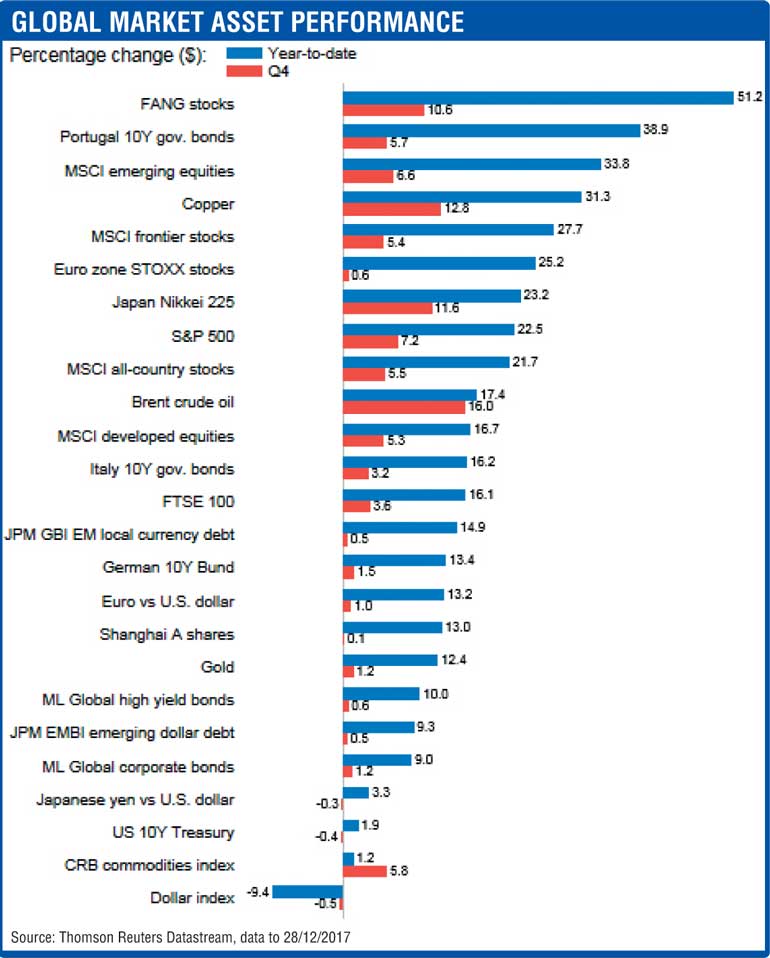Tuesday Dec 02, 2025
Tuesday Dec 02, 2025
Wednesday, 10 January 2018 00:00 - - {{hitsCtrl.values.hits}}
 LONDON (Reuters): Foreign investors poured $ 235 billion into emerging markets as they rallied strongly last year, allowing developing countries to add more than $ 130 billion to their hard-currency reserves, the Institute of International Finance said on Monday.
LONDON (Reuters): Foreign investors poured $ 235 billion into emerging markets as they rallied strongly last year, allowing developing countries to add more than $ 130 billion to their hard-currency reserves, the Institute of International Finance said on Monday.
The $235 billion “portfolio flow” figure was the best in three years and roughly a third higher than the $152 billion seen in 2016, the IIF data showed.
Emerging market debt was the clear favourite, attracting more than $170 billion of the total foreign capital inflow, versus $99 billion in 2016. Asia was the top pick regionally, accounting for roughly half of total figure.
“EM portfolio flows have had the best year since 2014,” the finance industry group said in a new report.
“It was the first calendar year since 2012 without a single month of combined equity and debt outflows — in line with the ultra-low volatility seen throughout the year across global markets.”
Emerging markets enjoyed one of their best performances on record last year with MSCI’s 24-country EM stocks index adding a third to its value and local currency EM debt returning almost 15% in dollar terms.
The Washington DC-based IIF said net outflows from China, a figure that includes all forms of capital flows, should also be modest at around $60 billion, compared $640 billion in 2016. But outflows of close to $25 billion in November pointed to a weaker end to the year, it added.
Broader emerging markets also experienced net capital outflows of $12 billion in November, following three months of solid inflows.
“Despite the tepid pace of inflows in the second half, 2017 was a year free of any of the major reversal events that have plagued prior years,” the IIF said.
It also estimated that emerging market central banks accumulated more than $132 billion of hard currency reserves in 2017, marking a sharp improvement from massive reserve losses in 2015 and 2016.
Aided by currency valuation effects, reserves rose by $30 billion to over $5.6 trillion in November, marking the 11th straight month of gains.
While reserves are at a more than two-year high, some countries’ may still be inadequate, the Washington-based IFF warned, naming Ukraine, Turkey, Hungary and Chile.
Calculations also suggest China’s official international reserves would be inadequate if capital controls, which currently prevent money large sums of money leaving the country, were to become “ineffective”.
“This concern may be behind the recent introduction of new capital controls to cap overseas withdrawals using domestic Chinese banks to around $15,000 per year,” the IIF said.
Reuters: Foreign investors were net sellers of Asian equities in December as they booked profits, however, analysts expect inflows into the region to pick up this year.
December data from seven Asian exchanges showed foreign outflows for the month totalled about $3.7 billion. For 2017, the region received $20 billion in foreign money.
Jingyi Pan, market strategist at IG markets in Singapore, said profit taking had been a key reason for the offloading of Asian equities in December. However, she doesn’t expect this trend to persist in 2018.
“The momentum may even pick up as investors turn to look at the cheaper alternatives to the likes of the US market,” said Pan.
Despite a big stock rally last year, Asian shares are still cheaper than stock markets in the United States and Europe. Asia’s forward 12-month price-to-earnings ratio stood at 15.3, against North America’s 22.3 and Europe’s 17, according to Thomson Reuters data.
Asian stocks have started this year on a positive note, with MSCI’s broadest index of Asia-Pacific shares outside Japan rising more than 3% already. The index rose more than 33% in 2017.
Expecting higher exports in Asia, driven by a synchronised global recovery, analysts are raising their 2018 earnings outlook for Asian companies. Over the past month, analysts have increased their earnings forecasts for Asian companies by 1.5%, with India, Vietnam and South Korean companies seeing the biggest upgrades.
DBS Bank expects Asian markets in aggregate to have returns of 3-15% in 2018 in local currency terms, excluding dividends.
However, analysts believe major central banks’ more aggressive monetary policies could be a risk for foreign flows this year.
The recent US jobs data showed gains in monthly wages in December, which could pave the way for the Federal Reserve to increase interest rates in March. “The only concern (for Asian equities) may be the degree of volatility that central banks’ tightening could bring to the relatively riskier Asia market that may dent sentiment and fund flows,” said IG markets’ Pan.